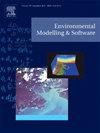通过考虑主要的溪流驱动因素,为偏差校正国家水模型输出提供了一个后处理机器学习框架
IF 4.8
2区 环境科学与生态学
Q1 COMPUTER SCIENCE, INTERDISCIPLINARY APPLICATIONS
引用次数: 0
摘要
虽然国家水模型(NWM)提供了全美范围内的高分辨率大尺度河水流量数据,但在干旱频发的美国西部地区,该模型作为重要水资源管理工具的有效性还需要进一步研究。先前的研究表明,受水库运行和未明确纳入模型框架的分流影响,国家水文模型在受控流域存在局限性。针对在整个美国西部观察到的模型技能下降的情况,我们开发了一个与模型无关的后处理机器学习(PP-ML)框架,以考虑水资源管理和区域主导水文过程对模型性能的影响。在 PP-ML 框架的案例应用中,我们使用每日 NWM v2.1 回溯流量作为水文模型,并输入上游水库蓄水量、SNOTEL 雪水当量和集水区特征。在大盐湖流域(因其易受干旱影响而备受关注的重要流域)应用 PP-ML 框架后,我们观察到,与 NWM 输出结果相比,30 个测量点的 Kling-Gupta 效率、偏差百分比和均方根误差中值分别提高了 65%、335% 和 25%。通过比较不同水流状态和测站类型的模型技能,发现在上游水利基础设施较多的测站(如受水库运行影响的测站)以及水管理活动可忽略不计的集水区,低流量估计值有了大幅提高(225%)。这项研究强调了利用 ML 对水文模型输出进行后处理如何能够考虑到水管理活动对河水流量估算的影响,尤其是在没有明确纳入基础设施规则集的情况下,并展示了其根据区域主要河水流量驱动因素对河水流量预报进行偏差校正的能力。本文章由计算机程序翻译,如有差异,请以英文原文为准。
A post-processing machine learning framework for bias-correcting National Water Model outputs by accounting for dominant streamflow drivers
While the National Water Model (NWM) provides high-resolution, large-scale streamflow data across the United States, its effectiveness as a key water resources management tool in the drought-prone Western US needs further investigation. Previous studies revealed that the NWM has limitations in controlled basins, impacted by reservoir operations and diversions not explicitly included within the model framework. Responding to the observed reduction in model skill throughout the Western US, we developed a model agnostic post-processing machine learning (PP-ML) framework to account for the impacts of water resources management and regionally dominant hydrological processes on model performance. For our case application of the PP-ML framework, we use daily NWM v2.1 retrospective flow rates as the hydrological model and input upstream reservoir storage, SNOTEL snow water equivalent, and catchment characteristics. Applying the PP-ML framework in the contributing Great Salt Lake watersheds, a key watershed of interest due to its drought-prone nature, we observed a 65%, 335%, and 25% improvement in the median Kling-Gupta Efficiency, Percent Bias, and Root Mean Square Error, respectively, for 30 gauged locations compared to the NWM outputs. Comparing model skills across different flow regimes and station types revealed a substantial (225%) improvement in low-flow estimates at stations with extensive upstream water infrastructure, such as those impacted by reservoir operations, as well as in catchments within negligible water management activities. The research underscores how post-processing hydrological model outputs with ML can account for the effects of water management activities on streamflow estimates, most notably without explicitly incorporating infrastructure rulesets, and demonstrate its capability in bias-correcting streamflow forecasts in response to the regionally dominant streamflow drivers.
求助全文
通过发布文献求助,成功后即可免费获取论文全文。
去求助
来源期刊

Environmental Modelling & Software
工程技术-工程:环境
CiteScore
9.30
自引率
8.20%
发文量
241
审稿时长
60 days
期刊介绍:
Environmental Modelling & Software publishes contributions, in the form of research articles, reviews and short communications, on recent advances in environmental modelling and/or software. The aim is to improve our capacity to represent, understand, predict or manage the behaviour of environmental systems at all practical scales, and to communicate those improvements to a wide scientific and professional audience.
 求助内容:
求助内容: 应助结果提醒方式:
应助结果提醒方式:


